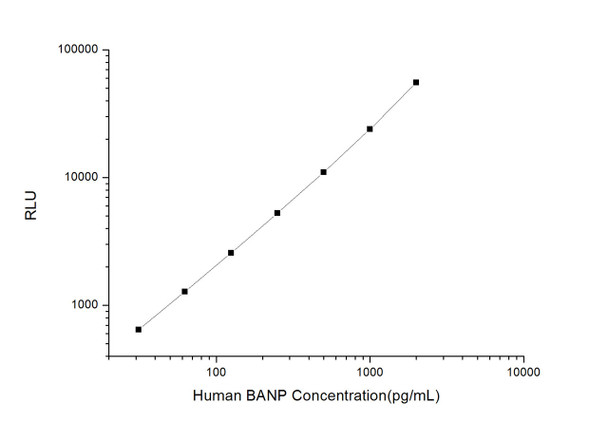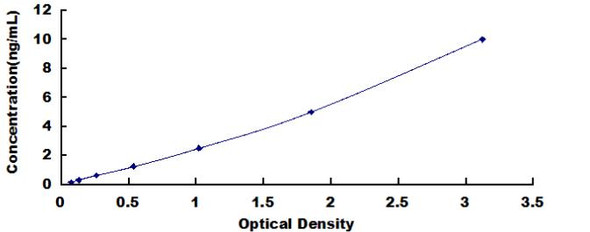Human Cell Cycle ELISA Kits 1
Human BANP (BTG3 Associated Nuclear Protein) CLIA Kit (HUES01269)
- SKU:
- HUES01269
- Product Type:
- ELISA Kit
- ELISA Type:
- CLIA Kit
- Size:
- 96 Assays
- Sensitivity:
- 18.75pg/mL
- Range:
- 31.25-2000pg/mL
- ELISA Type:
- Sandwich
- Reactivity:
- Human
- Sample Type:
- Serum, plasma and other biological fluids
- Research Area:
- Cell Cycle
Description
| Assay type: | Sandwich |
| Format: | 96T |
| Assay time: | 4.5h |
| Reactivity: | Human |
| Detection method: | Chemiluminescence |
| Detection range: | 31.25-2000 pg/mL |
| Sensitivity: | 18.75 pg/mL |
| Sample volume: | 100µL |
| Sample type: | Serum, plasma and other biological fluids |
| Repeatability: | CV < 15% |
| Specificity: | This kit recognizes Human BANP in samples. No significant cross-reactivity or interference between Human BANP and analogues was observed. |
This kit uses Sandwich-CLIA as the method. The micro CLIA plate provided in this kit has been pre-coated with an antibody specific to Human BANP. Standards or samples are added to the appropriate micro CLIA plate wells and combined with the specific antibody. Then a biotinylated detection antibody specific for Human BANP and Avidin-Horseradish Peroxidase (HRP) conjugate are added to each micro plate well successively and incubated. Free components are washed away. The substrate solution is added to each well. Only those wells that contain Human BANP, biotinylated detection antibody and Avidin-HRP conjugate will appear fluorescence. The Relative light unit (RLU) value is measured spectrophotometrically by the Chemiluminescence immunoassay analyzer. The RLU value is positively associated with the concentration of Human BANP. The concentration of Human BANP in the samples can be calculated by comparing the RLU of the samples to the standard curve.
| UniProt Protein Function: | BANP: Controls V(D)J recombination during T-cell development by repressing T-cell receptor (TCR) beta enhancer function. Binds to scaffold/matrix attachment region beta (S/MARbeta), an ATC-rich DNA sequence located upstream of the TCR beta enhancer. Represses cyclin D1 transcription by recruiting HDAC1 to its promoter, thereby diminishing H3K9ac, H3S10ph and H4K8ac levels. Promotes TP53 'Ser-15' phosphorylation and nuclear accumulation, which causes cell cycle arrest. Belongs to the BANP/SMAR1 family. 6 isoforms of the human protein are produced by alternative splicing. |
| UniProt Protein Details: | Protein type:Tumor suppressor Chromosomal Location of Human Ortholog: 16q24 Cellular Component: nucleoplasm Molecular Function:protein binding; DNA binding; p53 binding Biological Process: transcription, DNA-dependent; regulation of transcription, DNA-dependent; multicellular organismal development; chromatin modification; negative regulation of protein catabolic process; cell cycle |
| NCBI Summary: | This gene encodes a protein that binds to matrix attachment regions. The protein forms a complex with p53 and negatively regulates p53 transcription, and functions as a tumor suppressor and cell cycle regulator. Multiple transcript variants encoding different isoforms have been found for this gene. [provided by RefSeq, Mar 2010] |
| UniProt Code: | Q8N9N5 |
| NCBI GenInfo Identifier: | 308153628 |
| NCBI Gene ID: | 54971 |
| NCBI Accession: | Q8N9N5. 3 |
| UniProt Related Accession: | Q8N9N5 |
| Molecular Weight: | |
| NCBI Full Name: | Protein BANP |
| NCBI Synonym Full Names: | BTG3 associated nuclear protein |
| NCBI Official Symbol: | BANP |
| NCBI Official Synonym Symbols: | BEND1; SMAR1; SMARBP1 |
| NCBI Protein Information: | protein BANP |
| UniProt Protein Name: | Protein BANP |
| UniProt Synonym Protein Names: | BEN domain-containing protein 1; Btg3-associated nuclear protein; Scaffold/matrix-associated region-1-binding protein |
| Protein Family: | Protein |
| UniProt Gene Name: | BANP |
| UniProt Entry Name: | BANP_HUMAN |
As the RLU values of the standard curve may vary according to the conditions of the actual assay performance (e. g. operator, pipetting technique, washing technique or temperature effects), the operator should establish a standard curve for each test. Typical standard curve and data is provided below for reference only.
| Concentration (pg/mL) | RLU | Average | Corrected |
| 2000 | 53004 58438 | 55721 | 55693 |
| 1000 | 23712 24236 | 23974 | 23946 |
| 500 | 11153 10911 | 11032 | 11004 |
| 250 | 4893 5695 | 5294 | 5266 |
| 125 | 2623 2593 | 2608 | 2580 |
| 62.5 | 1356 1266 | 1311 | 1283 |
| 31.25 | 653 695 | 674 | 646 |
| 0 | 27 29 | 28 | -- |
Precision
Intra-assay Precision (Precision within an assay): 3 samples with low, mid range and high level Human BANP were tested 20 times on one plate, respectively.
Inter-assay Precision (Precision between assays): 3 samples with low, mid range and high level Human BANP were tested on 3 different plates, 20 replicates in each plate.
| Intra-assay Precision | Inter-assay Precision | |||||
| Sample | 1 | 2 | 3 | 1 | 2 | 3 |
| n | 20 | 20 | 20 | 20 | 20 | 20 |
| Mean (pg/mL) | 98.20 | 194.12 | 696.97 | 105.50 | 200.85 | 691.98 |
| Standard deviation | 8.02 | 20.52 | 77.22 | 9.22 | 17.88 | 79.23 |
| C V (%) | 8.17 | 10.57 | 11.08 | 8.74 | 8.90 | 11.45 |
Recovery
The recovery of Human BANP spiked at three different levels in samples throughout the range of the assay was evaluated in various matrices.
| Sample Type | Range (%) | Average Recovery (%) |
| Serum (n=5) | 84-99 | 91 |
| EDTA plasma (n=5) | 99-114 | 107 |
| Cell culture media (n=5) | 95-109 | 101 |
Linearity
Samples were spiked with high concentrations of Human BANP and diluted with Reference Standard & Sample Diluent to produce samples with values within the range of the assay.
| Serum (n=5) | EDTA plasma (n=5) | Cell culture media (n=5) | ||
| 1:2 | Range (%) | 90-104 | 90-104 | 94-106 |
| Average (%) | 97 | 97 | 100 | |
| 1:4 | Range (%) | 95-107 | 96-113 | 101-120 |
| Average (%) | 100 | 103 | 109 | |
| 1:8 | Range (%) | 84-100 | 100-116 | 100-115 |
| Average (%) | 91 | 106 | 105 | |
| 1:16 | Range (%) | 88-100 | 94-107 | 97-115 |
| Average (%) | 94 | 99 | 105 |
An unopened kit can be stored at 4°C for 1 month. If the kit is not used within 1 month, store the items separately according to the following conditions once the kit is received.
| Item | Specifications | Storage |
| Micro CLIA Plate(Dismountable) | 8 wells ×12 strips | -20°C, 6 months |
| Reference Standard | 2 vials | |
| Concentrated Biotinylated Detection Ab (100×) | 1 vial, 120 µL | |
| Concentrated HRP Conjugate (100×) | 1 vial, 120 µL | -20°C(shading light), 6 months |
| Reference Standard & Sample Diluent | 1 vial, 20 mL | 4°C, 6 months |
| Biotinylated Detection Ab Diluent | 1 vial, 14 mL | |
| HRP Conjugate Diluent | 1 vial, 14 mL | |
| Concentrated Wash Buffer (25×) | 1 vial, 30 mL | |
| Substrate Reagent A | 1 vial, 5 mL | 4°C (shading light) |
| Substrate Reagent B | 1 vial, 5 mL | 4°C (shading light) |
| Plate Sealer | 5 pieces | |
| Product Description | 1 copy | |
| Certificate of Analysis | 1 copy |
- Set standard, test sample and control (zero) wells on the pre-coated plate and record theirpositions. It is recommended to measure each standard and sample in duplicate. Note: addall solutions to the bottom of the plate wells while avoiding contact with the well walls. Ensuresolutions do not foam when adding to the wells.
- Aliquot 100 µL of standard solutions into the standard wells.
- Add 100 µL of Sample / Standard dilution buffer into the control (zero) well.
- Add 100 µL of properly diluted sample (serum, plasma, tissue homogenates and otherbiological fluids. ) into test sample wells.
- Cover the plate with the sealer provided in the kit and incubate for 90 min at 37 °C.
- Aspirate the liquid from each well, do not wash. Immediately add 100 µL of BiotinylatedDetection Ab working solution to each well. Cover the plate with a plate seal and gently mix. Incubate for 1 hour at 37 °C.
- Aspirate or decant the solution from the plate and add 350 µL of wash buffer to each welland incubate for 1-2 minutes at room temperature. Aspirate the solution from each well andclap the plate on absorbent filter paper to dry. Repeat this process 3 times. Note: a microplatewasher can be used in this step and other wash steps.
- Add 100 µL of HRP Conjugate working solution to each well. Cover with a plate seal andincubate for 30 min at 37 °C.
- Aspirate or decant the solution from each well. Repeat the wash process for five times asconducted in step 7.
- Add 100 µL of Substrate mixture solution to each well. Cover with a new plate seal andincubate for no more than 5 min at 37 °C. Protect the plate from light.
- Determine the RLU value of each well immediately.






